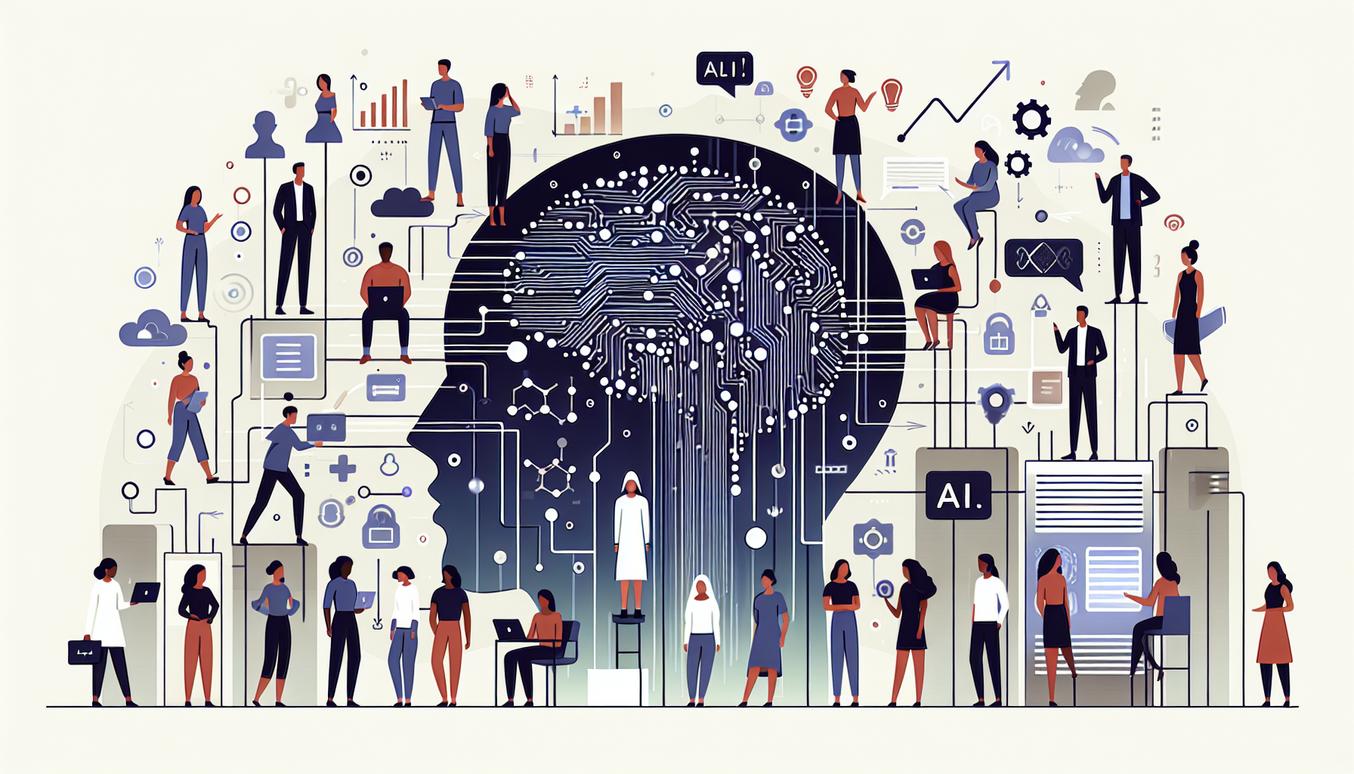Driving Business Value Through AI Innovation: A 2025 Strategic Whitepaper for Leaders
A Comprehensive Guide to Harnessing the Power of Artificial Intelligence for Measurable Impact and Sustainable Growth.
- Executive Summary
- Reading the Current AI Landscape
- Core Technologies Overview
- Responsible AI Governance and Ethics
- Security, Robustness and Resilience
- Measuring Value: Metrics and KPIs
- Implementation Roadmap for Leaders
- Operationalizing Models and MLOps Practices
- Challenges, Trade-offs and Mitigation Strategies
- Concise Case Studies and Lessons Learned
- Further Reading, Glossary and Resources
Executive Summary
Artificial Intelligence (AI) has transcended its origins as a theoretical discipline to become a primary driver of business transformation and competitive advantage. For Chief Technology Officers, AI leaders, and product strategists, the central challenge is no longer *if* they should adopt AI, but *how* to deploy it responsibly, strategically, and for measurable return on investment. This whitepaper serves as a definitive guide to navigating the complex world of AI innovation. It combines a technical primer on the foundational technologies shaping the industry—from deep learning to generative models—with a practical executive roadmap for implementation. We will explore high-impact use cases across key sectors like healthcare and finance, underscore the critical importance of ethical governance and robust security, and provide actionable frameworks for measuring value and operationalizing models at scale. The goal is to equip leaders with the knowledge to move beyond proofs-of-concept to building a sustainable, value-generating AI ecosystem within their organizations.
Reading the Current AI Landscape
The field of AI is characterized by relentless acceleration. We have moved from narrow AI, capable of performing specific tasks, to the cusp of more generalized and multimodal systems that can understand and process information across text, images, and audio. The current landscape is dominated by the maturation of large-scale models, the democratization of AI tools through cloud platforms, and a growing, non-negotiable emphasis on responsible deployment. True AI innovation is now less about algorithmic novelty alone and more about the sophisticated integration of these powerful tools into core business processes to solve complex problems. Understanding this shift is the first step toward building a successful AI strategy.
Core Technologies Overview
A strategic grasp of the core technologies is essential for any leader navigating the AI space. This section breaks down the foundational pillars driving modern AI innovation.
Neural Architectures and Deep Learning
At the heart of modern AI are Artificial Neural Networks, computational models inspired by the human brain. Deep Learning, a subfield utilizing networks with many layers (hence “deep”), has been the catalyst for recent breakthroughs. These architectures excel at identifying complex patterns in large datasets.
- Convolutional Neural Networks (CNNs): The standard for image and video analysis, powering applications from medical imaging to autonomous navigation.
- Recurrent Neural Networks (RNNs): Designed to handle sequential data, making them ideal for time-series analysis, and forming the basis for early natural language models.
- Transformer Architectures: The current state-of-the-art for language tasks, their attention mechanism allows them to weigh the importance of different words in a sequence, enabling a more profound contextual understanding.
Generative Systems and Creative Models
Generative AI represents a paradigm shift from analytical to creative capabilities. These models learn the underlying distribution of a dataset to generate new, original content. This wave of AI innovation is powered by models like Large Language Models (LLMs) for text and diffusion models for imagery, enabling applications in content creation, software development, and synthetic data generation for training other AI systems.
Advances in Natural Language Processing
Natural Language Processing (NLP) has evolved from simple keyword matching to genuine semantic understanding. Modern NLP systems, built on transformer architectures, can perform sophisticated tasks such as summarization, sentiment analysis, translation, and conversational AI with unprecedented accuracy. This enables more natural human-computer interaction and the automation of knowledge-intensive work.
Reinforcement Learning in Production
Reinforcement Learning (RL) is a behavioral training model where an AI agent learns to make optimal decisions by performing actions in an environment to maximize a cumulative reward. While computationally intensive, RL is finding its place in production for dynamic optimization problems, such as logistics routing, robotic control systems, and resource allocation in data centers.
AI in Healthcare: Opportunities and Safeguards
The potential for AI in Healthcare is immense, with applications in diagnostic imaging, drug discovery, personalized treatment plans, and operational efficiency. However, the stakes are exceptionally high. Safeguards, including robust data privacy protocols (adhering to regulations like HIPAA), model transparency for clinical decisions, and rigorous testing to mitigate bias, are not optional but essential for ethical and effective implementation.
AI in Finance: Use Cases and Risk Controls
In finance, AI innovation drives algorithmic trading, real-time fraud detection, personalized financial advice, and automated underwriting. The primary challenge is managing risk. Effective risk controls include ensuring model explainability for regulatory compliance (Explainable AI or XAI), continuous monitoring for model drift, and implementing safeguards against market manipulation or biased lending practices.
Automation and Autonomous Systems
AI is the engine of intelligent automation. This extends beyond robotic process automation (RPA) to encompass complex, adaptive systems. Key areas include:
- Supply Chain Optimization: Predictive analytics for demand forecasting and autonomous routing to improve logistics resilience.
- Smart Manufacturing: AI-powered quality control, predictive maintenance, and robotic automation on the factory floor.
- Autonomous Vehicles: Integration of computer vision, sensor fusion, and decision-making algorithms to enable self-driving capabilities.
Cognitive Computing and Decision Science
Cognitive computing aims to simulate human thought processes in a computerized model. In a business context, this involves using AI to augment human intelligence, not replace it. These systems can analyze vast and unstructured datasets to identify patterns, evaluate hypotheses, and provide data-backed recommendations, empowering leaders to make faster, more informed strategic decisions.
Responsible AI Governance and Ethics
As AI systems become more powerful and autonomous, a formal governance structure for responsible AI is a business imperative. This is central to sustainable AI innovation. Adhering to frameworks like the NIST AI Risk Management Framework provides a structured approach.
Key Pillars of Responsible AI
- Fairness: Actively identifying and mitigating harmful bias in data and algorithms to ensure equitable outcomes.
- Accountability: Establishing clear lines of ownership for AI system behavior and decisions.
- Transparency: Making AI systems understandable to their users and stakeholders, often through explainability (XAI) techniques.
- Privacy: Incorporating privacy-preserving techniques and ensuring compliance with data protection regulations.
Security, Robustness and Resilience
AI systems introduce unique security vulnerabilities that require specialized defense strategies. A resilient AI infrastructure must be hardened against both traditional cyber threats and AI-specific attacks.
Common AI Security Threats
- Adversarial Attacks: Maliciously crafted inputs designed to fool a model into making an incorrect prediction.
- Data Poisoning: Corrupting the training data to compromise the integrity of the resulting model.
- Model Inversion and Theft: Attempts to reverse-engineer a model to steal intellectual property or expose sensitive training data.
Building robustness involves techniques like adversarial training, rigorous data validation, and continuous monitoring for anomalous behavior.
Measuring Value: Metrics and KPIs
The success of an AI initiative cannot be measured by technical metrics alone. Leaders must tie AI projects to tangible business outcomes. This requires moving beyond model accuracy and F1 scores to focus on Key Performance Indicators (KPIs) that matter to the business.
| Technical Metric | Corresponding Business KPI |
|---|---|
| Model Prediction Accuracy | Reduction in operational errors, improved sales forecast accuracy |
| Inference Speed (Latency) | Improved customer experience, real-time fraud detection rate |
| Model Uptime | Service reliability, reduction in system downtime costs |
| Automation Rate | Increase in employee productivity, reduction in manual processing costs |
Implementation Roadmap for Leaders
A phased approach is critical for de-risking investment and building momentum for widespread AI innovation.
Phase 1: Strategy and Assessment (Beginning 2025)
- Identify High-Value Use Cases: Map AI capabilities to core business challenges and opportunities. Start with problems that are well-defined and have accessible data.
- Assess Data Readiness: Evaluate the quality, quantity, and accessibility of your data. A robust data infrastructure is the foundation of any AI strategy.
- Establish Governance: Form a cross-functional steering committee to define ethical guidelines and success metrics.
Phase 2: Pilot and Prototyping (2025-2026)
- Develop Proofs-of-Concept (PoCs): Execute small-scale pilot projects to validate technical feasibility and business value.
- Build Foundational Capabilities: Invest in the necessary talent and MLOps infrastructure to support scaling.
- Iterate and Learn: Embrace a fail-fast mentality. Use learnings from pilots to refine the broader strategy.
Phase 3: Scaling and Operationalization (2026 and Beyond)
- Industrialize Successful Pilots: Systematically scale proven use cases across the organization.
- Democratize AI Tools: Empower business units with governed, self-service AI platforms and training.
- Foster an AI-Driven Culture: Promote data literacy and a culture of continuous learning and experimentation.
Operationalizing Models and MLOps Practices
Machine Learning Operations (MLOps) is the discipline of automating and standardizing the machine learning lifecycle to enable reliable and efficient deployment and maintenance. It is the key to moving from experimentation to enterprise-scale AI innovation. MLOps integrates the model development process (data scientists) with the model operations process (IT/DevOps), covering:
- Data Management and Versioning: Tracking datasets used for training to ensure reproducibility.
- Continuous Integration/Continuous Delivery (CI/CD): Automating the testing and deployment of models.
- Model Monitoring: Actively tracking model performance in production to detect drift or degradation.
- Automated Retraining: Establishing triggers for automatically retraining and deploying updated models when performance declines.
Challenges, Trade-offs and Mitigation Strategies
The path to AI maturity is fraught with challenges. Proactive identification and mitigation are essential.
- Data Scarcity and Quality: Many organizations struggle with siloed or poor-quality data. Mitigation: Invest in a modern data governance strategy and consider synthetic data generation for training.
- Talent Shortage: Specialized AI talent is scarce and expensive. Mitigation: Invest in upskilling your existing workforce and partner with specialist firms or academic institutions.
- Integration Complexity: Integrating AI models with legacy IT systems can be difficult. Mitigation: Adopt an API-first design philosophy and prioritize modern, cloud-native architectures.
- Ethical and Regulatory Uncertainty: The legal and ethical landscape for AI is still evolving. Mitigation: Establish a strong internal ethics board and stay abreast of emerging regulations.
Concise Case Studies and Lessons Learned
Case Study 1: Retail Demand Forecasting
A global retailer deployed an RL-based system to optimize inventory management. The model analyzed real-time sales data, weather patterns, and local events to predict demand with 25% greater accuracy than previous methods.
Lesson Learned: The biggest value unlock came from integrating external, unstructured data sources. Investment in data pipelines was as critical as the algorithm itself.
Case Study 2: Financial Services Fraud Detection
A bank replaced its rules-based fraud detection engine with a deep learning model. The new system identified complex fraud patterns in real-time, reducing false positives by 40% and improving the detection of novel fraud schemes.
Lesson Learned: Ensuring model explainability was paramount for regulatory approval and for fraud investigators to trust the system’s alerts. A hybrid approach combining the AI model with human oversight proved most effective.
Further Reading, Glossary and Resources
Glossary of Key Terms
- Deep Learning: A subset of machine learning using multi-layered neural networks to learn from vast amounts of data.
- Generative AI: AI models capable of creating new content, such as text, images, or code.
- Large Language Model (LLM): A massive deep learning model trained on vast text data to understand and generate human-like language.
- MLOps (Machine Learning Operations): A set of practices to deploy and maintain machine learning models in production reliably and efficiently.
- Reinforcement Learning (RL): A type of machine learning where an agent learns to make decisions by taking actions in an environment to maximize a reward.
Resource Links
- Neural Networks: https://en.wikipedia.org/wiki/Artificial_neural_network
- Generative AI: https://en.wikipedia.org/wiki/Generative_model
- Reinforcement Learning: https://en.wikipedia.org/wiki/Reinforcement_learning
- Natural Language Processing: https://en.wikipedia.org/wiki/Natural_language_processing
- Responsible AI Framework: https://www.nist.gov/topics/artificial-intelligence
- AI in Healthcare Context: https://www.who.int/health-topics/digital-health









